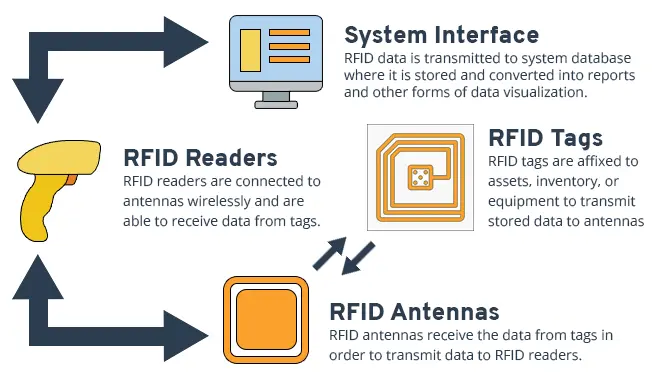
If you’ve ever walked through a warehouse and wondered how anyone keeps track of all those pallets, bins, and boxes — the answer is often RFID technology.
Accurate inventory is one of the most important factors when it comes to maintaining an effective supply chain. Traditional methods of inventory management, such as manual counting and barcode scanning, often fall short in terms of accuracy and efficiency. In fact, studies show that manual inventory counts have an accuracy rate of only 63%, while RFID can achieve up to 99.9% accuracy. This highlights the urgency for organizations to adopt new methods that ensure higher levels of inventory tracking.
RFID revolutionizes how businesses manage their inventory without upending an organization’s operations or incurring large costs.
This is why companies such as Walmart, Target, Macy’s, Nordstrom, and dozens more are making RFID a central part of their supply chain strategy. But RFID inventory management is applicable beyond just retail. This article explores how RFID can manage inventory, delving into its benefits, applications, and potential challenges.

How RFID Works
How RFID Manages Inventory
RFID manages inventory by turning physical assets into digital data points that can be tracked automatically. Every item, pallet, or container is tagged with a small RFID chip containing a unique identifier. These tags communicate with RFID readers using radio waves — no line of sight required — allowing hundreds of tags to be read in just seconds.
When items move through key points in your operation — such as receiving docks, storage areas, or shipping lanes — RFID readers capture the tag data and send it to your inventory management system. The software then updates stock counts, locations, and movement history in real time.
This automation eliminates manual scanning and data entry, which are major sources of error in traditional systems. Instead of employees logging items one by one, RFID systems continuously track what’s entering, leaving, or relocating within your facility.
Modern RFID setups often include:
- Fixed readers and antennas at doorways, portals, or conveyors for automated data capture
- Handheld readers for mobile spot-checking and cycle counts
- Middleware or IoT software (like Edgefinity IoT) that filters, processes, and syncs tag data with ERP or WMS platforms
The result is a dynamic, always-accurate view of your inventory. You can see what’s on hand, what’s in motion, and what’s missing — without waiting for a manual audit or report. In short, RFID transforms inventory management from a periodic process into a continuous, intelligent system.
How Does RFID Improve Inventory Accuracy Compared to Traditional Methods?
Traditional inventory methods — like barcode scanning or manual counts — rely heavily on human input. Every scan, click, or clipboard check introduces room for error. RFID eliminates most of that friction. Because RFID tags can be read automatically and in bulk — even when hidden inside boxes or stacked on shelves — it captures far more data, far more accurately.
Instead of a worker scanning one item at a time, RFID readers can identify hundreds of items per second without line of sight. This means fewer missed scans, fewer miscounts, and an up-to-the-minute record of what’s really in stock. Many organizations see their inventory accuracy jump from around 70–80% with manual or barcode systems to over 99% with RFID.
| Feature | Barcode | RFID |
|---|---|---|
| Read Range | Must be scanned directly | Can be read from several feet away |
| Line of Sight | Required | Not required |
| Scan Speed | One at a time | Hundreds per second |
| Durability | Susceptible to wear | Can withstand harsh conditions |
| Data Storage | Limited | Can hold detailed product info |
Applications of RFID Inventory Management
Using RFID to tracking inventory is applicable to virtually any industry. However, these are the most common areas where RFID is being used to improve inventory accuracy:
Retail
In the retail industry, accurate inventory management is crucial for maintaining optimal stock levels and meeting customer demands. RFID technology helps retailers achieve higher inventory accuracy, reducing stockouts and overstock situations. It also enhances the shopping experience by ensuring that products are always available on the shelves.
Some retailers use RFID for self-checkout systems, where customers can scan all items in their cart simultaneously, speeding up the checkout process.
Manufacturing
Manufacturers use RFID to track raw materials, work-in-progress items, and finished goods throughout the production process. This real-time visibility helps manufacturers optimize their production schedules, reduce lead times, and improve overall efficiency.
RFID also aids in quality control by tracking the production history of each item, ensuring that only products meeting quality standards proceed to the next stage.
Healthcare
In the healthcare sector, RFID inventory management is used to track medical supplies, equipment, and pharmaceuticals. This ensures that critical items are always available when needed, reducing the risk of stockouts.
RFID also helps in tracking the usage and maintenance schedules of medical equipment, ensuring that devices are in proper working condition.
Logistics and Warehousing
In logistics and warehousing, RFID provides real-time visibility into the movement of goods, from the warehouse to the delivery destination. This visibility helps logistics providers optimize their routes, reduce transportation costs, and ensure timely deliveries.
RFID also streamlines the receiving and shipping processes by automating data capture, reducing the need for manual entry.

RFID ROI Calculator
Take the guesswork out of your investment with our ROI calculator. See potential savings and discover how RFID can enhance operations across industries.
Challenges and Considerations
While RFID inventory management delivers major advantages, it’s not without challenges. The initial investment can be significant — RFID tags, readers, and integration software all add up. Yet many organizations find the long-term payoff in accuracy, labor savings, and automation more than justifies the upfront cost.
Another key consideration is system integration. Connecting RFID with existing ERP or warehouse management platforms can be complex, often requiring workflow adjustments or software customization. Ensuring compatibility from the start helps avoid headaches later. Finally, data security must be prioritized.
RFID systems generate massive volumes of real-time data, which must be securely stored and protected to prevent unauthorized access or breaches.
Conclusion
RFID technology has proven to be a game-changer in inventory management, offering real-time visibility, improved accuracy, efficiency, and enhanced security. By automating the inventory management process, RFID helps businesses maintain optimal inventory levels, reduce losses, and improve overall operational efficiency. While there are challenges to consider, the benefits of RFID inventory management make it a worthwhile investment for businesses looking to stay competitive in today’s fast-paced market.
As technology continues to evolve, the adoption of RFID in inventory management is expected to grow, driving further innovation and efficiency.
Interested in RFID?
An RFID tracking system can help organizations of all sizes improve their supply chain efficiency. Contact the CYBRA team to schedule a demo today.















 RFID Cage
RFID Cage